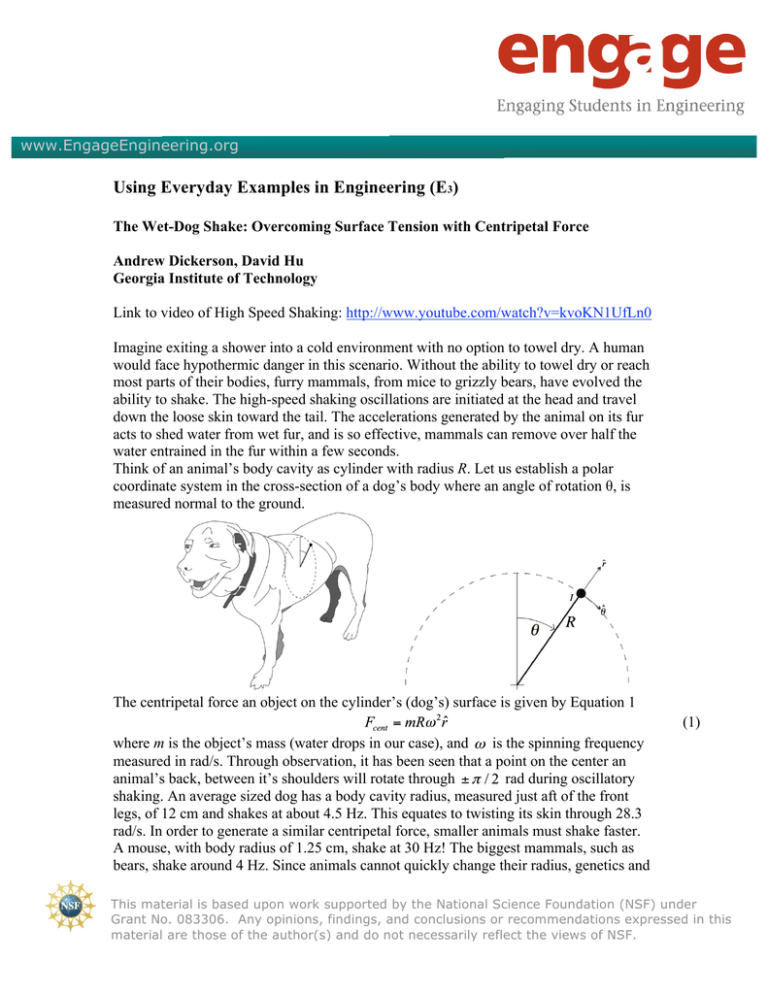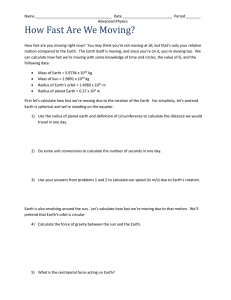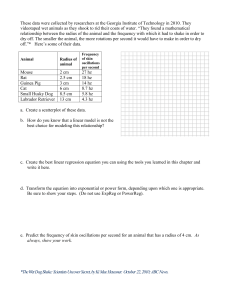
www.EngageEngineering.org
Using Everyday Examples in Engineering (E3)
The Wet-Dog Shake: Overcoming Surface Tension with Centripetal Force
Andrew Dickerson, David Hu
Georgia Institute of Technology
Link to video of High Speed Shaking: http://www.youtube.com/watch?v=kvoKN1UfLn0
Imagine exiting a shower into a cold environment with no option to towel dry. A human
would face hypothermic danger in this scenario. Without the ability to towel dry or reach
most parts of their bodies, furry mammals, from mice to grizzly bears, have evolved the
ability to shake. The high-speed shaking oscillations are initiated at the head and travel
down the loose skin toward the tail. The accelerations generated by the animal on its fur
acts to shed water from wet fur, and is so effective, mammals can remove over half the
water entrained in the fur within a few seconds.
Think of an animal’s body cavity as cylinder with radius R. Let us establish a polar
coordinate system in the cross-section of a dog’s body where an angle of rotation θ, is
measured normal to the ground.
The centripetal force an object on the cylinder’s (dog’s) surface is given by Equation 1
(1)
where m is the object’s mass (water drops in our case), and
is the spinning frequency
measured in rad/s. Through observation, it has been seen that a point on the center an
animal’s back, between it’s shoulders will rotate through
rad during oscillatory
shaking. An average sized dog has a body cavity radius, measured just aft of the front
legs, of 12 cm and shakes at about 4.5 Hz. This equates to twisting its skin through 28.3
rad/s. In order to generate a similar centripetal force, smaller animals must shake faster.
A mouse, with body radius of 1.25 cm, shake at 30 Hz! The biggest mammals, such as
bears, shake around 4 Hz. Since animals cannot quickly change their radius, genetics and
This material is based upon work supported by the National Science Foundation (NSF) under
Grant No. 083306. Any opinions, findings, and conclusions or recommendations expressed in this
material are those of the author(s) and do not necessarily reflect the views of NSF.
muscular dynamics choose a sufficient frequency based on size. There seems to be little
dependence of shaking frequency on species.
Evaluate: calculate the acceleration (
) of the average dog. Convert the units
2
to m/s and calculate the number of g’s the skin, and water trapped inside, experiences.
Let us think of centripetal force as an outward force for now. What is a mammal trying to
overcome by shaking so violently? The surface tension of water causes it to coalesce with
itself, adhere to many surfaces, and resist external forces. Surface tension is the culprit
for water drops sticking to your window and wetting your clothes. Water finds the
position of lowest energy in every situation.
Centripetal force is actually a force that keeps an object in its path of rotation. This may
be counter-intuitive, but centripetal translates to “center-seeking.”
Experience: stand on the center of a carousel and have a friend spin it at a near constant
rotational velocity. Increase your radius to the center by moving outwards. What do you
feel?
The force that our hands and feet provide, keeps us planted on a spinning carousel. We
experience what feels like a force pulling us outwards that is actually the tendency of our
mass to continue in straight-line motion. If you were on the edge of a carousel of radius r
and spinning with angular velcoity and let go, you would eject in a straight line at a
velocity given by Equation 2
(2)
The water ejected from a dog’s fur also ejects in a straight line.
Picture a particle on a dog’s back as it shakes. The path the particle travels can be
modeled as a sine wave
(3)
where A is the maximum angle of deflection (
rad). The second derivative of
Equation 3 will allow for the calculation of the maximum acceleration the skin
experiences. The looseness of the skin allows it to deflect much greater angles than the
body rotates, which is about
rad.
Elaborate: the interested student will calculate the number of g’s the skin experience on
direction change for a given A where
.
Engineering Application: Think about how we typically dry clothes in a washing
machine. Could this be made better by what we’ve seen in nature?
For more information visit:
dickerson.gatech.edu
All images and graphics by: Andrew Dickerson, Georgia Institute of Technology
© 2011 Andrew Dickerson and David Hu. All rights reserved. Copies may be
downloaded from www.EngageEngineering.org. This material may be
reproduced for educational purposes.


